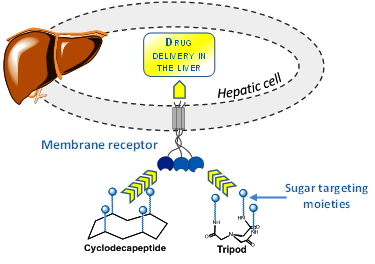Drug targeting is an attractive and powerful therapeutic strategy that is proposed to enhance drug efficacy and to decrease the many side-effects associated with systemic drug therapy. Indeed, it achieves specific drug accumulation in the diseased organ or cells. This strategy is exploited at our laboratory to target liver cells for the treatment of Wilson disease, a genetic disorder characterized by a copper overload in the liver. Current treatments are based on systemic copper chelation to decrease copper in the body or to limit its absorption. They show a large number of side-effects and are not efficient in a significant number of patients.
Efficient copper chelating agents developed at our laboratory were targeted specifically to the liver by decorating them with sugar moieties that are known to specifically interact with biological receptors present at liver cell membranes. The physiological role of these receptor is to promote the entry of certain proteins in these cells. Therefore the drugs decorated with sugars specifically enter the liver cells
via a similar mechanism.
The cellular incorporation of the copper chelators decorated with sugars was studied by flow cytometry in collaboration with
LCBM and DCM/I
2BM and with the support of the LabEx Arcane and the “Fondation pour la Recherche Médicale”. These decorated drugs enter the hepatic cells
via the targeted receptor and the incorporation efficiency is highly dependent on the number of sugar grafted on the drug. The best candidates have three to four sugar units and their cellular uptake is 1000 - 10000 times more efficient than one isolated sugar unit.
Importantly, the affinity of these targeted drugs for the receptor is high enough to compete with proteins present
in vivo. Those chemical architectures are therefore expected to be good vehicles for drug delivery in hepatocytes in a variety of liver diseases.
